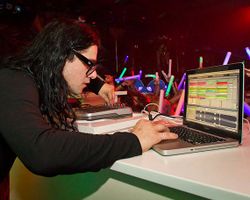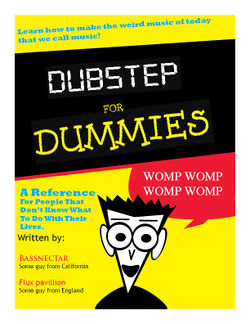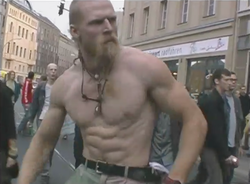Dubstep
“I never met a woman that didn't want me to wub them all night.”

Dubstep is the name given for a deafening, cacophonous sound produced by slamming the keys of a laptop whilst hooked up to a turntable and speakers. Much like Crunkcore, Dubstep's aggressively loud and thunderous sounds found an audience with drugged up or drunk young people , especially those who loiter about rave clubs and attend cigarette fueled outdoor concert festivals like Electric Zoo.
History of Dubstep[edit | edit source]
Although the original traditions have since been lost, Dubstep originated in the High Middle Ages. During knighting ceremonies, wherein a squire was dubbed as a knight, the newly honored paladin often performed a dance. Intended as a lighthearted dance, the reality was that in a suit of armor, any movement at all is rugged and wobbly. The players of the dubstep music inevitably incorporated this fact into their repertoire, strongly influencing the modern sounds of today.
Dubstep was invented in 1991 by Rolf Harris as he experimented with his wobble board while laying down filthy basslines on his didgeridoo. Rolf was taken back by the new sound he had created and branded it 'Dubstep' after his daughter. Although some claim that this is a myth, all of the evidence has thus far made it almost indisputable that Rolf is in fact the founding father of dubstep.
As Dubstep gained moderate popularity in the late 90's and early 00's, however it was mostly an underground sensation, especially outside of England. In the early 10's Dubstep's popularity surged as younger audiences were tired of hearing similar sounding songs put out by the same few artists year after year.In the early 10's Dubstep's popularity surged as younger audiences were tired of hearing similar sounding songs put out by the same few artists year after year. By the mid 10's Dubstep slowly declined in popularity due to how everyone was fed-up with every dubstep song sounding the same and having talentless artists illegally copying music dealing with copyright infringement.

In 2012, mainstream dubstep artist Skrillex won three grammy awards, this pissed off the majority of Dubstep's core audience of hipsters. You'd think actual music fans would have been pissed off at this too, but the Grammy's don't count. Despite the awards not being televised this story has been picked up by major reputable news organisations making Skrillex a household name. Skrillix's popularity surged so much that major fashion designers like Vera Wang and Tommy Hillfiger each recently had a model with a "side mullet" in their fashion shows.
Modern Dubstep[edit | edit source]
Modern dubstep is slightly different than it's roots, with the popularity of Computers and the Internet production has changed dramatically and you don't actually need talent to create a passable song. A classic example of modern dubstep is Tchaikovsky's 2012 Overture. This is a VIP of the 1812 Overture, the earlier work done by Tchaikovsky himself.
Modern Dubstep differentiates itself from "classical" dubstep by attempting to push the envelope and not sound like techno, trance, house, or music. This has created a race to make the most insane songs and several new genres like brostep, bruvstep, and most recently fartstep. Dubstep can be recognized by its frequent and often ear-shattering bass drops, wubs, clips of a person screaming "CALL 911 NOW!!", and the sound of all your hopes and dreams being crushed at once. Ignore that part.
Modern dubstep is also distinct in that it is completely acceptable (in fact, it is often expected) to be completely lacking in any musical or tonal quality whatsoever. And whereas other music genres have generally accepted guidelines in order to create actual music, dubstep is unique in the way it seeks to create genuine pain upon hearing it (the level of pain usually expected is approximately equivalent to that of spending a half-hour of using a cheese grater on your eye).
Dubstep Production[edit | edit source]
Originally Dubstep was produced on very expensive equipment called synthesizers, however this required the artist to have enough money to be able to afford this equipment, or be able to run fast enough to not get caught stealing it. However now any aspiring artist with a Macbook can create dubstep and become famous and one day win a Grammy.
There is a large selection of software available to dubstep producers, generally this software is quite expensive for most aspiring dubstep artists so it is very common for them to seek other means of procurement
Parts of a Typical Song[edit | edit source]
Typical Dubstep songs are almost always comprised of the same four basic parts. More seasoned artists will often substitute other steps in for the basic four, or add them in addition to the standard ones.
The Drop[edit | edit source]
The drop is a misdirection tactic used by the artist to create a sense of suspense within a song. This is achieved by playing a nice melody that fades off, causing a pause. In 99.9% of cases this melody will be the most listenable part of the track, it will become offensive to the ears after this point.
A common misconception is that an artist "drops" the bass (see Wub Wub). However, this is inaccurate as many early musicians would talk about dropping the volume to create a fade. Urban Legend has it that Run DMC created the drop when they accidentally smoked marijuana prior to a show, causing Reverend Run to accidentally drop a record he was about to play, causing a short pause in the track.
Wub Wub[edit | edit source]
The "Wub Wub" (or repeating modulated bass riff) is named by it's typical sound and always follows the drop. Where as most bass lines will include at least 3 different musical notes at some point, dubstep relies on repeating the same fucking note 18 million times. Some professional musicians will change up the basic sound of the "Wub Wub" to make it seem like they are creating a new song. Sometimes instead of "wub wub" the bass line will sound like "yob yob".
Beat Down[edit | edit source]
The beat down section is a where an artist will repeat a few simple heavy beats to encourage people to mosh. Dubstep moshes can be very unpredictable depending on the drug of choice for that crowd. For example, if most people are taking Ecstasy the mosh is more or less a hugfest. However if most people have been doing pot there's a good chance someone is going to get punched for burning dinner, Karen!
Weed is not a popular dubstep drug as it's a gateway to harder drugs whereas dubstep is a harder music who's fans came to it by way of the gateway gene Techno.
Repeat[edit | edit source]
Once all of the required steps are completed, it is typical for the musician to start over from the beginning, often times this is done to kill time. This is done to kill time. And once all of the required steps are completed, it is typical for the musician to start over from the beginning.
Additional Steps[edit | edit source]
Sometimes professional musicians will add in a few additional steps that they heard in other songs to make their song stand out.
Double Time[edit | edit source]
Double Time is where an artist increases tempo temporarily, this is usually done to replace a beat down when they inadvertently create a song that sounds too much like another song they've already made. Double time is the most popular of all of the non-essential steps.
Half Time[edit | edit source]
This is similar to Double Time, however, instead of doubling the time, it is cut in half. This is usually done when the artist created a song that was too fast to begin with and realized they couldn't get away with increasing the tempo so they just reduce it.
Half time party[edit | edit source]
This is an event that occurs during a football game and has no bearing here.
Chopped Vocals[edit | edit source]
Chopping vocals is usually done when all other effects have been explored. An artist will take the vocals from the track they are working on and around them shuffle or cho of th ver en o eac wor. Sometimes artists choose to mix in vocals from other songs that don't belong, often times gibberish is flurg bnible margnzzzzt as a result.
This effect is popular in remixes of other people's dubstep songs since it allows the remixer to obscure the original vocals, making it seem like the song is entirely new and fooling the listener into believing actual effort was put into the music
Shock[edit | edit source]
Sometimes artists will attempt to take listeners by surprise by slowly lowering the volume of a track and suddenly raise it to it's maximum. The desired effect is to shock listeners and make them "shit brix". This tactic is desirable in live performances as the performer is paid for the night and if they can manage to make the entire audience crap their pants they can go home and play videogames sooner.


